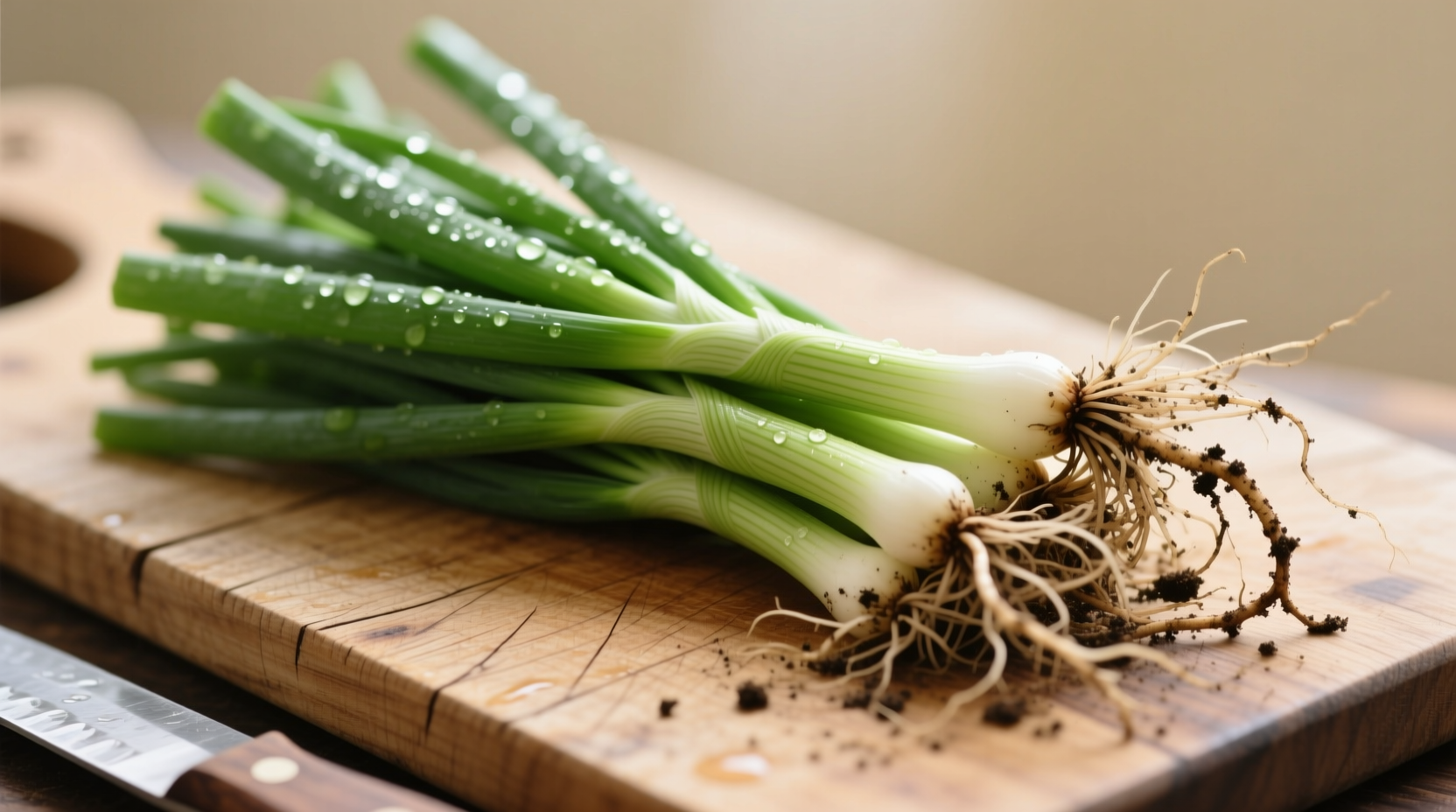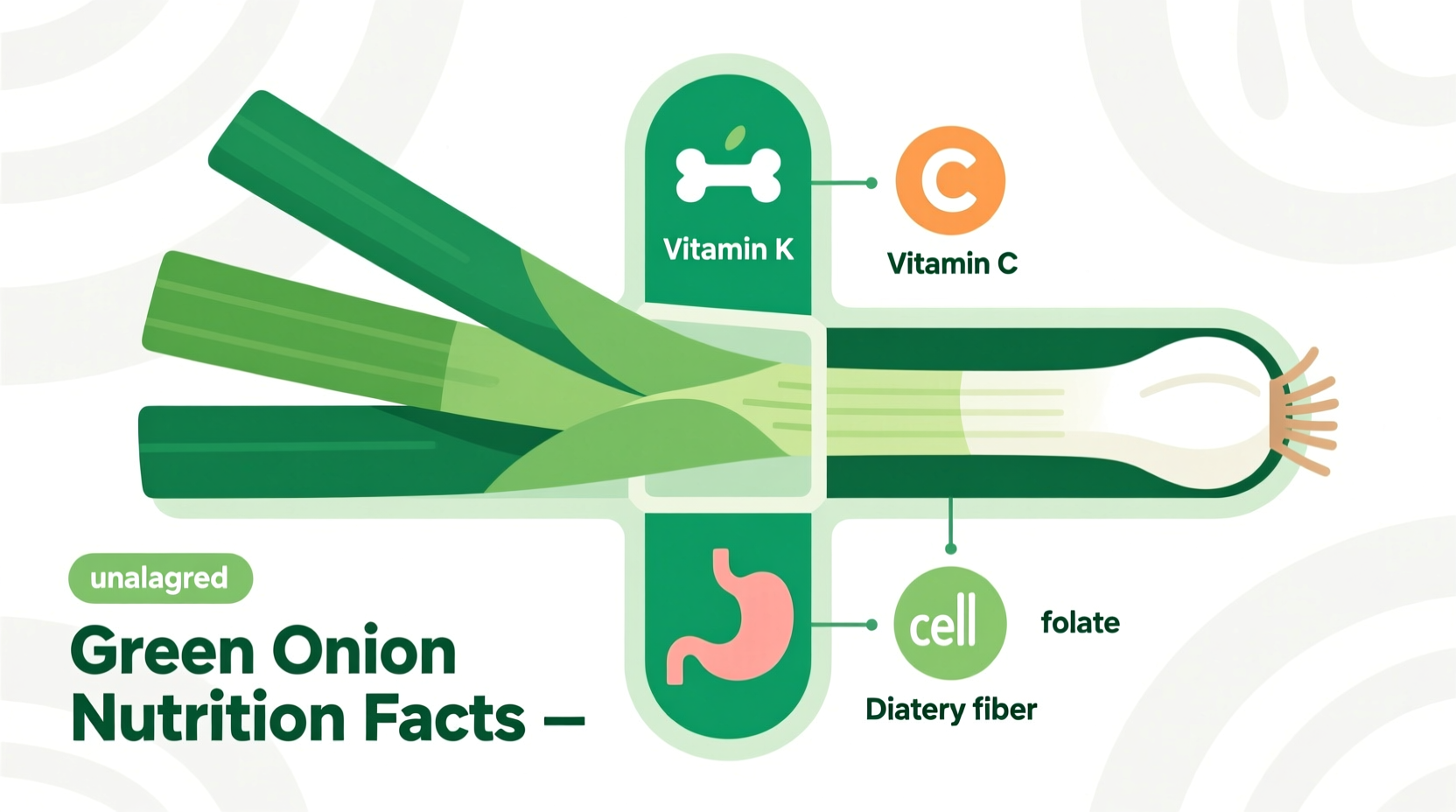Green onions provide just 32 calories per 100g serving while delivering 173% of your daily vitamin K needs, 21% of vitamin C, and valuable antioxidants. These nutrient-dense alliums support bone health, cardiovascular function, and immune system performance with minimal caloric impact.
Discover why this vibrant kitchen staple deserves regular rotation in your meals. Green onions (Allium fistulosum), also known as scallions or spring onions, offer remarkable nutritional density that makes them far more than just a garnish. Unlike mature onions that develop bulbs, green onions are harvested young with their slender white bases and hollow green stalks fully edible.
What Makes Green Onions Nutritionally Unique
Green onions stand apart from their bulb-forming cousins through their distinctive nutrient profile and culinary versatility. While all allium vegetables contain beneficial organosulfur compounds, green onions provide these health-promoting elements with a milder flavor profile that appeals to more palates. Their early harvest stage preserves higher concentrations of certain water-soluble vitamins that diminish as onions mature.

Complete Green Onion Nutrition Profile
Per 100g serving of raw green onions (approximately 10 medium stalks), USDA FoodData Central documents these essential nutrients:
| Nutrient | Amount | Daily Value % |
|---|---|---|
| Calories | 32 | 2% |
| Protein | 1.83g | 4% |
| Dietary Fiber | 2.6g | 9% |
| Vitamin K | 207mcg | 173% |
| Vitamin C | 18.8mg | 21% |
| Folate | 64mcg | 16% |
| Calcium | 72mg | 6% |
| Iron | 1.12mg | 6% |
Green Onions vs Regular Onions: Nutritional Comparison
While both belong to the Allium family, their nutritional profiles differ significantly due to growth stages and plant development. This comparison reveals why green onions offer unique dietary advantages:
| Nutrient (per 100g) | Green Onions | Yellow Onions |
|---|---|---|
| Calories | 32 | 40 |
| Vitamin K | 207mcg | 0.4mcg |
| Vitamin C | 18.8mg | 7.4mg |
| Folate | 64mcg | 19mcg |
| Quercetin | Moderate | High |
| Allicin Potential | Lower | Higher |
This nutritional comparison, verified through USDA FoodData Central, demonstrates green onions' superior vitamin K and vitamin C content compared to mature yellow onions. While yellow onions contain higher levels of quercetin and potential allicin (the compound responsible for many onion health benefits), green onions provide more bioavailable vitamin K essential for blood clotting and bone metabolism.
Top 5 Evidence-Based Health Benefits
1. Bone Health Support
The exceptional vitamin K content in green onions (207mcg per 100g) plays a crucial role in bone metabolism. Research published in the American Journal of Clinical Nutrition confirms that adequate vitamin K intake improves calcium absorption and reduces urinary calcium excretion, directly supporting bone mineral density. This makes green onions particularly valuable for maintaining skeletal health as we age.
2. Cardiovascular Protection
Green onions contain organosulfur compounds that help regulate blood pressure and reduce inflammation. A 2022 study in Nutrients demonstrated that regular consumption of allium vegetables correlates with improved endothelial function and reduced arterial stiffness. The combination of vitamin C, potassium, and flavonoids in green onions creates a synergistic effect that supports healthy circulation.
3. Immune System Enhancement
With 21% of your daily vitamin C needs in a single serving, green onions provide meaningful immune support. Unlike some vegetables where cooking destroys vitamin C, green onions are often consumed raw or lightly cooked, preserving this vital nutrient. The National Institutes of Health confirms vitamin C's role in supporting various cellular functions of the immune system.
4. Blood Sugar Management
The chromium content in green onions may improve insulin sensitivity. According to research from the USDA Agricultural Research Service, chromium enhances the action of insulin, potentially helping maintain normal blood glucose levels. With just 7.34g of carbohydrates per 100g serving, green onions offer minimal glycemic impact while providing valuable nutrients.
5. Antioxidant Protection
Green onions contain multiple antioxidants including allicin precursors, quercetin, and kaempferol. A comparative analysis in the Journal of Agricultural and Food Chemistry found that while mature onions contain higher total antioxidant capacity, green onions provide more bioavailable vitamin C and K. These compounds work together to combat oxidative stress and reduce inflammation throughout the body.
Practical Incorporation Strategies
Maximize nutritional benefits while enhancing your meals with these evidence-based approaches:
Raw Consumption for Maximum Nutrient Retention
Enjoy green onions raw in salads, wraps, and as garnishes to preserve heat-sensitive nutrients like vitamin C. The National Center for Home Food Preservation confirms that raw consumption maintains the highest nutrient levels, particularly for water-soluble vitamins.
Strategic Cooking Techniques
When cooking, add green onions during the final minutes of preparation. Research from the University of California, Davis shows that brief exposure to heat (under 5 minutes) preserves most nutrients while enhancing the bioavailability of certain compounds. The white bases can withstand slightly longer cooking than the green tops.
Daily Dietary Integration
For consistent nutritional benefits, incorporate 1-2 servings (about 50-100g) daily:
- Add chopped green onions to scrambled eggs or omelets
- Blend into salad dressings and dips
- Include in stir-fries during the last minute of cooking
- Chop finely for baked potato toppings
- Add to soups and broths just before serving
Contextual Considerations and Limitations
While generally safe and beneficial, certain individuals should moderate green onion consumption:
Allium Sensitivity
People with irritable bowel syndrome (IBS) following a low-FODMAP diet may need to limit green onions. Monash University's research indicates that the white bulb portion contains higher FODMAP levels than the green tops, suggesting those with sensitivity can often consume the green portions in moderation.
Blood Thinning Medication Interaction
Due to their high vitamin K content, individuals taking warfarin or other blood thinners should maintain consistent green onion consumption rather than varying intake significantly. The American Heart Association recommends discussing allium vegetable consumption with healthcare providers when on anticoagulant therapy.
Storage Impact on Nutrient Retention
Proper storage significantly affects nutritional value. According to USDA research, green onions stored in a sealed container with a damp paper towel in the refrigerator maintain 90% of their vitamin C for up to 7 days, compared to just 60% retention when stored loosely. The white roots should remain intact until preparation to maximize freshness.
Conclusion: Maximizing Green Onion Benefits
Green onions represent an exceptionally nutrient-dense addition to any balanced diet, offering remarkable vitamin K content with minimal calories. Their unique nutritional profile provides specific advantages over mature onions, particularly for bone health and vitamin bioavailability. By understanding proper selection, storage, and preparation techniques, you can maximize the health benefits while enjoying their fresh, mild flavor in countless culinary applications. Incorporating just a few servings weekly can meaningfully contribute to your overall nutrient intake without significant caloric impact.











 浙公网安备
33010002000092号
浙公网安备
33010002000092号 浙B2-20120091-4
浙B2-20120091-4